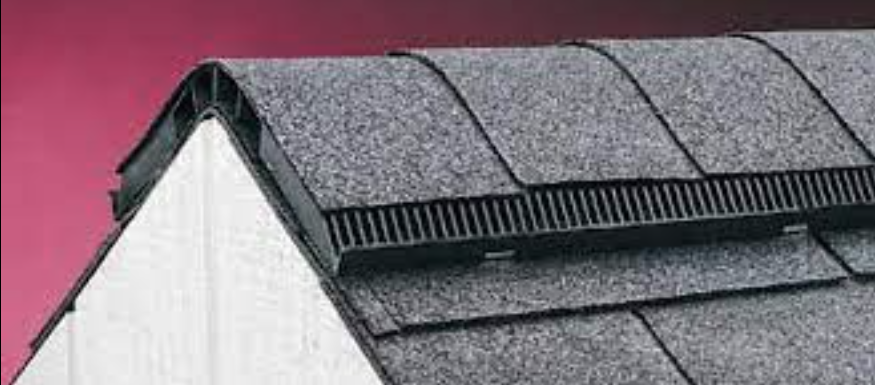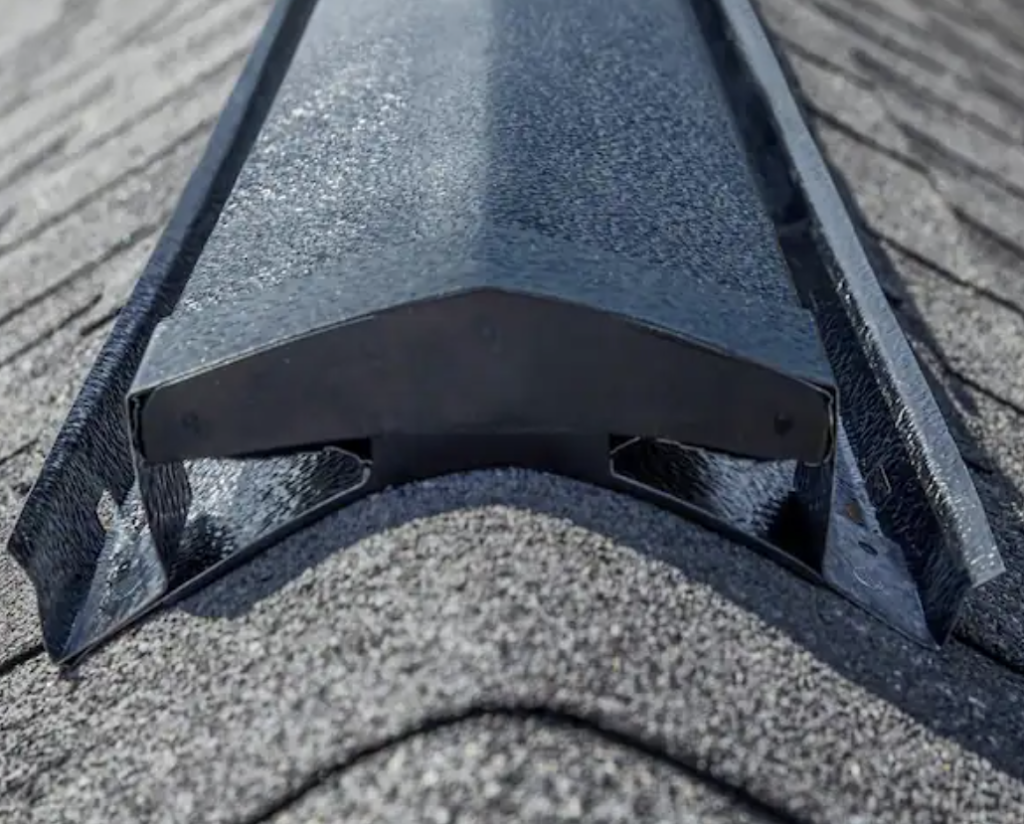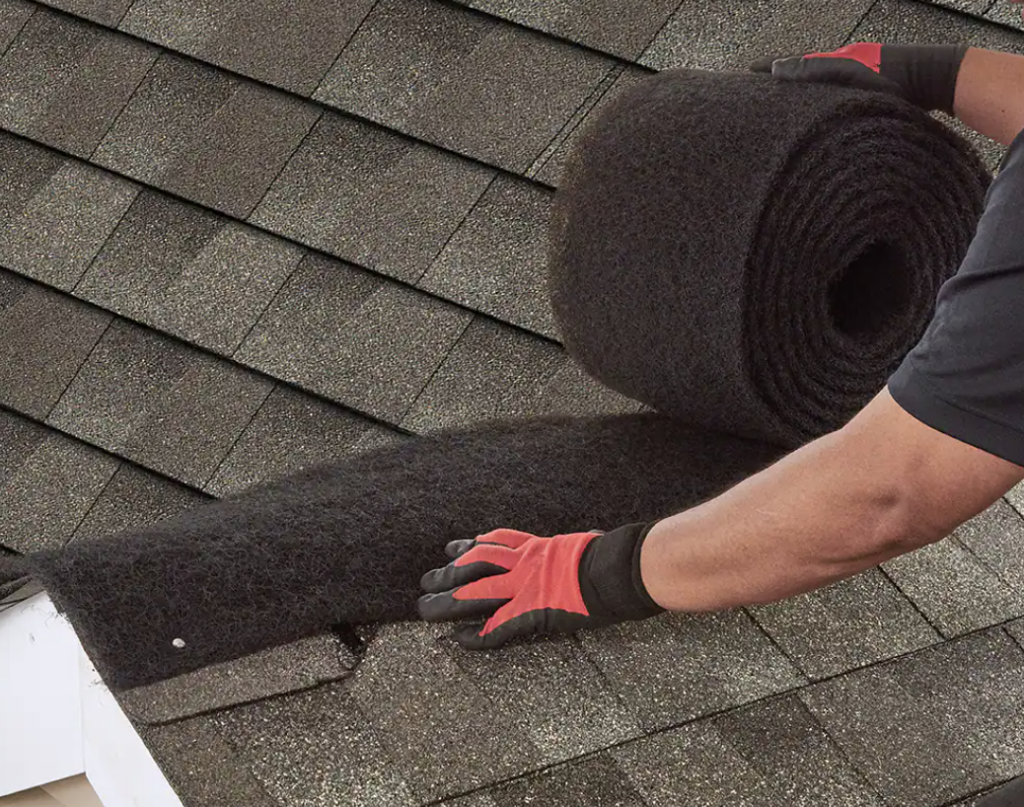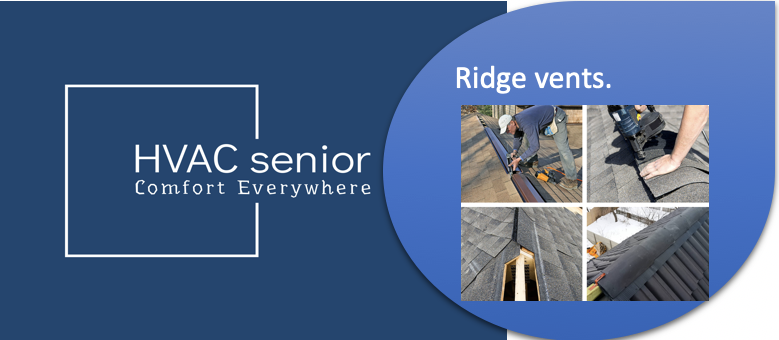Explore more on Ridge Vents.
Imagine living in a house where the air is always moving, keeping a careful balance between efficiency and comfort. This is where ridge vents comes in.
Imagine a system that skill-fully combines innovative architecture with fundamental physics to produce this dreamy setting. The hidden heroes of contemporary roofing, ridge vents lift more than simply shingles.
A ridge vent is essentially an elegant, discreet conduit that runs along the peak of your roof. However, its simple exterior hides the radical change it can bring to your living quarters.
Imagine it as an air doorway, a channel that welcomes nature’s hush and arranges a symphony of circulation. This modest aperture, which is cleverly positioned along your roof’s highest point, holds the key to a slew of advantages that flow throughout your entire house.
Ridge vents use the basic principles of airflow to take advantage of warm air’s natural inclination to climb. The air beneath your roof warms up when the sun radiates warmth through it.
As warm, buoyant air smoothly ascends, it creates a mild vacuum that draws in cooler air from below, revealing scientific marvels.
The outcome? A constant exchange that removes extra heat, moisture, and stale air—exactly what compromises your comfort and raises energy costs.
A ridge vent, however, is more than just a decorative element; it is a useful tool that promotes energy efficiency, protects roofing materials, and promotes a better living environment.
Prepare to be mesmerized by the ridge vents’ understated elegance and significant impact as we set out on a quest to understand how they operate.Also check out soffit vent.
What Purpose does a Ridge Vent serve?
Enhanced Ventilation:
In order to provide efficient and continuous ventilation in the attic or roof space of a building, a ridge vent is essential.
It minimizes the buildup of heat and moisture, which can cause a number of problems like mold growth, decaying roofing materials, and decreased energy efficiency.
By enabling air to move freely.If you want to access more ventilation content, check out Ventilation for Ceiling and ventilation fans.
Temperature Regulation:
A ridge vent’s main objective is to promote natural convection. Due to solar radiation, heated air rises and leaves via the ridge vent, generating a vacuum that pulls in cooler air from lower intake vents.
This cyclical flow aids in temperature regulation in the attic, preventing overheating in the summer and lightening the demand on the cooling systems.
Moisture Mitigation:
Attic moisture buildup can seriously damage a building’s structural stability. Together with other ventilation components, a ridge vent helps to exhaust humid air, lowering the likelihood of condensation, rot, and water damage.
Energy Efficiency:
An effective ridge vent-driven attic ventilation system can have a big impact on how much energy is used. Cooling systems run more effectively and cost less to run when heat buildup is avoided.
Roof Longevity:
The deterioration of roofing materials can be accelerated by excessive heat retained in attics. Ridge vents keep temperatures steady and lessen the strain brought on by intense heat, extending the lifespan of a roof.
Healthier Indoor Environment:
Allergens, pollutants, and volatile organic compounds (VOCs) are less likely to build up indoors when there is enough ventilation. This improves indoor air quality and creates a healthier living environment.
Environmental Impact:
Ridge vents encourage natural cooling processes, which lessens the need for mechanical cooling systems that require energy and release greenhouse gases into the atmosphere.
Benefits of Ridge Vent
- Effective Ventilation: Ridge vents help to control temperature, humidity, and air quality by supplying efficient and reliable circulation within attics or roof spaces. By doing this, problems like mold growth and the deterioration of building components are avoided.
- Natural Cooling: Ridge vents make use of the idea that hot air rises. Warm air that has gathered beneath the roof exits through the ridge vent, drawing in cooler air from below. The entire living area and the attic are cooled by the natural convection process.
- Moisture Control: Insulation and roofing materials may become harmed by excessive dampness in attics. Ridge vents exhaust humid air, working in tandem with other ventilational elements to lower the likelihood of condensation and associated issues.
- Energy Efficiency: Ridge vents help reduce energy use by reducing heat accumulation. In a well-ventilated space, cooling systems operate more efficiently, reducing energy use and utility costs.
- Extended Roof Lifespan: The deterioration of roofing materials can be accelerated by high temperatures. Ridge vents manage attic temperatures, protecting the roof from overheating and extending its lifespan.
- Improved Indoor Air Quality: A healthier interior environment is produced through effective ventilation, which reduces the accumulation of allergies, pollutants, and toxic substances.
- Sustainability: Ridge vents make it easier for natural cooling processes to work, which lessens the need for energy-intensive cooling systems. This environmentally friendly strategy reduces the building’s carbon footprint and energy use.
- Enhanced Comfort: Ridge vents improve overall comfort in living spaces by maintaining controlled temperatures and humidity levels.
Types of Ridge Vent
There are various ridge vent types available, each created to meet certain roofing and ventilation requirements. Here are a few typical examples:
- Externally Baffled Ridge Vent.

This design has external baffles or deflectors that let air circulate while preventing rainfall and debris from entering. It is a well-liked option since it offers efficient ventilation in places with frequent rainfall.
- Internally Baffled Ridge Vent
This type features inside baffles that shield against rain and debris, just as the externally baffled variant. It often has a more understated appearance and gives the roofline a sleeker aspect.
- Filtered Ridge Vent

Filtered ridge vents have internal filters that stop dust, pollen, and other particles from traveling with the airflow into the attic. In places with high quantities of airborne pollution, they are especially helpful.
- Metal Ridge Vent.

Metal ridge vents provide longevity and resistance to weather factors because they are made of dependable materials like steel or aluminum. They are frequently utilized in places with severe weather.
- Shingle Over Ridge Vent.
This kind is made to mix in easily with asphalt shingles, giving the roof a more unified appearance. It’s a subdued choice that preserves the elegance of the roof.
- Ridge Vent with Electric Fan
When passive ventilation might not be enough, ridge vents with electric fans built in can increase airflow. Depending on the temperature or humidity conditions, these fans can be manually or automatically regulated.
- Cobra-Style Ridge Vent.

This style has a flexible, continuous design that can accommodate different roof lengths and pitches. Along the entire ridge, it enables constant ventilation.
- Multi-Purpose Ridge Vent.
Some ridge vents are made to perform various tasks, such as allowing space for solar panel installations or snow guards.
Ridge Vent vs. Roof Vent: Unveiling the Distinctions
Although both ridge vents and roof vents are essential parts of a properly ventilated roofing system, their functions and attributes are different. The main distinctions between these two ventilation choices are listed below:
Ridge Vent:
Location: Ridge vents are installed along the ridgeline, which is the peak where two roof slopes meet.
Airflow: They facilitate natural convection, allowing warm air to rise and exit the attic space through the ridge vent, while drawing in cooler air from lower intake vents.
Appearance: Ridge vents are often designed to blend discreetly with the roofline, maintaining a seamless aesthetic.
Functionality: They primarily exhaust hot air and moisture from the attic, regulating temperature and preventing issues like mold growth and roof deterioration.
Effectiveness: Ridge vents provide uniform airflow along the entire ridge, ensuring consistent ventilation throughout the attic space.
Compatibility: They are compatible with various roofing materials and styles, contributing to their versatility.
Roof Vent (Static or Power Vent):
Location: Roof vents, also known as attic vents, are installed on different parts of the roof’s surface.
Airflow: They promote passive ventilation by allowing air to escape from the attic space. Static roof vents rely on natural wind pressure, while power roof vents utilize electric fans to enhance airflow.
Appearance: Roof vents are visible on the roof’s surface and can vary in design, including box-like static vents and dome-shaped power vents.
Functionality: Roof vents exhaust hot air from the attic, preventing heat buildup and moisture-related issues. Power roof vents can provide additional ventilation in areas with inadequate natural airflow.
Effectiveness: The effectiveness of roof vents can vary based on their placement, the number installed, and the presence of obstructions like trees or nearby buildings.
Compatibility: Different roof vent styles and materials are available to suit various roofing types.
Choosing the Ideal Ventilation: Ridge Vent vs. Roof Vent
In order to achieve the highest levels of indoor comfort, energy efficiency, and defense against moisture-related issues, choosing the appropriate ventilation system for your roofing requirements is essential.
While both ridge vents and roof vents have their merits, one choice stands out as the obvious winner after a thorough comparison of all of the advantages, disadvantages, and practical considerations.
Ridge Vent:
Pros:
Ridge vents guarantee uniform ventilation along the whole ridge, ensuring steady airflow in the attic. Their understated design maintains beauty by smoothly blending into the roofline.
Ridge vents efficiently remove moisture and hot air, extending the life of roofing materials and halting the formation of mold.
They don’t use any mechanical parts for their passive convection technique, which lowers energy and maintenance expenses.
Cons:
Ridge vents may be less effective in areas with insufficient wind pressure to drive airflow. Their installation can be more intricate and may require a compatible roof design.
Roof Vent (Static or Power Vent):
Pros:
Roof vents, especially power vents, can enhance ventilation in areas with low natural wind pressure. They offer flexibility in placement and can address specific ventilation needs. Power roof vents are ideal for boosting airflow in challenging environments.
Cons:
Roof vents can disrupt the roof’s aesthetics and may require more frequent maintenance due to moving parts in power vents. Their effectiveness can vary based on placement and obstructions.
The Winning Choice: Ridge Vent
The scale leans in favor of ridge vents when you take into account their all-around benefits, which include regular airflow, visual appeal, the avoidance of moisture-related problems, and cost-effective operation.
They operate effectively all year long without relying on outside conditions thanks to their passive ventilation system.
While both solutions have advantages, ridge vents are the better option for obtaining ideal attic ventilation and a healthier, cozier home atmosphere due to their versatility, effectiveness, and longevity.
How Much Do Ridge Vents Cost
The type of ridge vent, the size of your roof, the material utilized, labor prices in your area, and any additional parts or accessories required for installation can all affect the price of ridge vents.
Here is a general breakdown of the cost factors:
- Type of Ridge Vent: Different types of ridge vents come at different price points. Basic externally baffled ridge vents might be more affordable, while higher-end options with additional features like filters or built-in fans can be more expensive.
- Roof Size and Complexity: The size, pitch, and complexity of your roof can influence the cost. Larger roofs will require more material and labor, potentially increasing the overall cost.
- Material: Ridge vents can be made from various materials, including metal, plastic, or composite materials. The material you choose can impact the cost.
- Labor Costs: Labor costs for installation can vary based on the complexity of the installation process, local labor rates, and the expertise of the roofing contractor.
- Additional Components: Depending on your roofing system and the specific ridge vent chosen, you might need additional components such as sealants, flashing, or connectors, which can add to the overall cost.
- Geographic Location: The cost of construction and labor can vary significantly from one region to another, so the location of your project will influence the final cost.
The average cost for installing ridge vents on a standard-sized home in the United States could range from $400 to $1,500.
What is the appropriate Number of Ridge Vents that a Roof should have?
Determining the suitable quantity of ridge vents for a roof hinge on various factors, such as.
- Roof dimensions
- Pitch,
- Ventilation requirements
As a general guideline, a balanced system of ridge vents should provide consistent airflow across the entire roofline.
Typically, a ratio of 1 linear foot of ridge vent for every 300 square feet of attic space is recommended. However, consulting with roofing professionals ensures a tailored approach, optimizing ventilation to enhance indoor comfort and safeguard the structural integrity of the roof.
The Need for a Ridge Vent in Your Roof: A Comprehensive Consideration
Why Your Roof Needs a Ridge Vent:
Temperature Regulation: Ridge vents facilitate the natural flow of air, preventing heat buildup in your attic during hot seasons.
This regulation helps maintain consistent indoor temperatures and eases the strain on your cooling systems.
Moisture Mitigation: Accumulated moisture can lead to mold growth, structural damage, and insulation degradation.
A ridge vent, working in tandem with intake vents, expels humid air and curbs moisture-related problems.
Energy Efficiency: By preventing excessive heat accumulation, ridge vents contribute to lower cooling costs. A well-ventilated attic reduces the demand on air conditioning, resulting in energy savings.
Extended Roof Lifespan: High attic temperatures can cause shingles to deteriorate faster. Ridge vents maintain cooler attic environments, preserving the integrity of roofing materials and extending their lifespan.
When a Ridge Vent Might Not Be Necessary:
Limited Attic Space: Homes with minimal or no attic space might not benefit from ridge vents, as there’s little room for hot air to accumulate.
Alternative Ventilation Methods: Homes with effective gable or soffit vents might not require ridge vents, as long as the overall ventilation system is properly balanced.
Roof Design Incompatibility: Some roof designs or materials might not be suitable for ridge vent installation, making alternative ventilation methods more appropriate.
Conclusion:
The benefits and suitability of a ridge vent must be carefully considered in order to determine whether your roof needs one.
Ridge vents are powerful tools for controlling temperature, moisture, energy use, and extending the life of your roof.
The need for ridge vents, however, might be lessened in some circumstances, such as those involving a small attic or different ventilation strategies. It’s critical to strike the ideal balance between your roof’s design, size, and regional climate.
Working with roofing professionals to develop a customized strategy is certain whether a ridge vent or other ventilation methods are used.
By choosing wisely, you can create a space that is not only well-ventilated but also cozy, energy-efficient, and ready to protect the structural integrity of your roof for many years to come.

